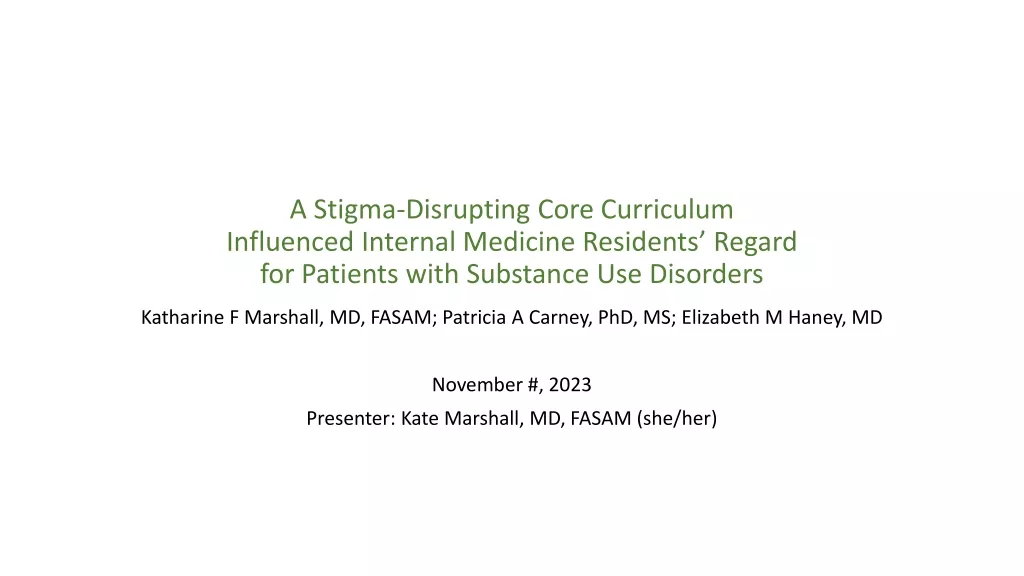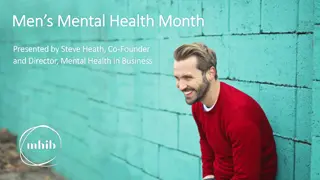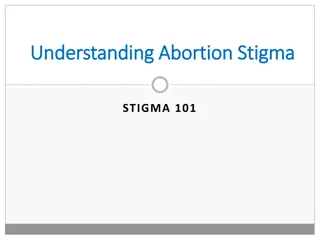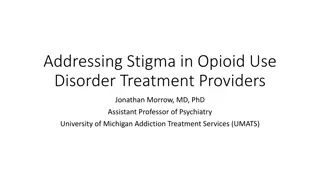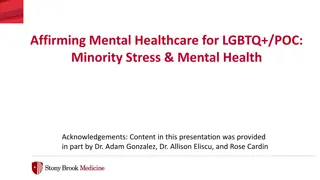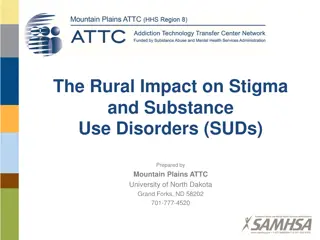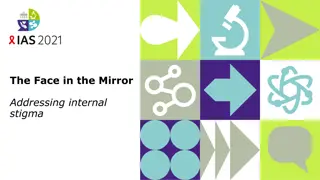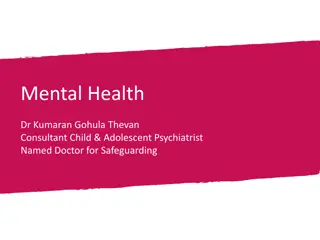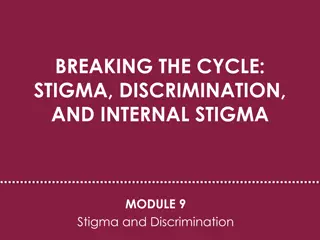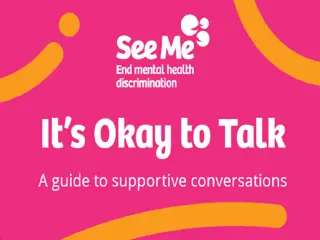Understanding and Addressing Self-Stigma in Mental Health
Explore the concept of self-stigma in mental health through activities and discussions, learn about the impact of self-stigma, and discover how peer mentors can help mitigate its effects. Delve into the definitions of stigma, stereotypes, prejudice, and discrimination, as well as their implications in a Canadian context.
Download Presentation

Please find below an Image/Link to download the presentation.
The content on the website is provided AS IS for your information and personal use only. It may not be sold, licensed, or shared on other websites without obtaining consent from the author. Download presentation by click this link. If you encounter any issues during the download, it is possible that the publisher has removed the file from their server.
E N D
Presentation Transcript
SELF-STIGMA Dr. Mike Condra condram@queensu.ca Queen s University
Agenda 1. Free Association Activity 2. What is Stigma and how can we recognize it? 3. Two types of Stigma 4. The Impact of Self-Stigma 5. How a Peer Mentor Can Help to lessen the impact of Self- Stigma
Free Association Activity (Part 1) Write down the first things that come to mind when you think of mental illness or a person with mental illness. Remember: There are no right or wrong answers. You don t have to personally believe in or agree with the ideas that you write down. Write down whatever comes to mind. Source: Centre for Addiction and Mental Health. (2012). Talking about mental illness: Teacher s resource. Retrieved from: http://www.camh.ca/en/education/teachers_school_programs/resources_for_teachers_and_schools/talking_about_mental_illness/Pages/ta mi_teachersresource.aspx
Free Association Activity (Part 2) Place your sticky notes on the wall under one of the four categories: myth (widely held, but false idea) misconception/misunderstanding hurtful/disrespectful language factual information Debrief: Did you have any difficulty placing the sticky notes? Why? What did you do in these cases? Source: Centre for Addiction and Mental Health. (2012). Talking about mental illness: Teacher s resource. Retrieved from: http://www.camh.ca/en/education/teachers_school_programs/resources_for_teachers_and_schools/talking_about_mental_illness/Pages/ta mi_teachersresource.aspx
What is Stigma? Think, Pair, Share Activity How would you define stigma? Think on your own Pair up and discuss with a partner Share your ideas with the class
What is Stigma? Definition of Stigma: Prejudicial attitudes and discriminatory behaviours targeted at people with mental health problems. A mark or sign of disgrace or discredit.
Terms Related to Stigma Stereotype A widely held but fixed and oversimplified image or idea of a particular type of person Prejudice A preconceived opinion that is not based on reason or actual experience Discrimination Unfavourable treatment based on prejudice
Canadian Context 50% of Canadians would not disclose that their family member has a mental illness to friends or co-workers 42% of Canadians don t know if they would socialize with a friend with a mental illness 64% of Ontario workers would be concerned about how work would be impacted if a colleague had a mental illness 46% of Canadians think people use the term mental illness as an excuse for bad behaviour 27% of Canadians say they would be fearful of being around someone who suffers from serious mental illness Source: Centre for Addiction and Mental Health. (2012). Mental illness and addictions: Facts and statistics. Retrieved from http://www.camh.ca/en/hospital/about_camh/newsroom/for_reporters/Pages/addictionmentalhealthstatistics.aspx
Three Components of Stigma 1. Lack of Knowledge: not understanding mental health 2. Negative Attitudes and Feelings: fear, shame 3. Negative Behaviours: shunning, judging, discriminating
Public or Social Stigma Public/Social stigma: The prejudicial attitudes and discriminatory behaviours expressed toward people with a mental illness by members of the public E.g. the ideas that people with mental illness can never recover; they are violent and unpredictable; they are blameworthy and could control their illness. Stupid Scary Incapable Inadequate Strange Crazy Faker Nut-Job Weak
What is Self-Stigma? Self-stigma: Self-stigma is when a person with a mental illness accepts and agrees with negative cultural stereotypes. They feel ashamed, blameworthy, and try to conceal their illness from others. E.g., when someone avoids situations that may elicit stigmatizing responses. Self-stigma is learned (and can be unlearned)
How Does Stigma Develop? 1. Awareness: The public believes people with mental illness are weak. 4. Harm: Because I am weak, I am not worthy or able. 3. Application: I have a mental illness so I must be weak. 2. Agreement: That s right. People with mental illness are weak. Staged Model of Self-Stigma (Adapted from Corrigan & Rao, 2012, p. 465)
The Impact of Self-Stigma Increased Distress/Pain Sense of Failure Sense of Shame Feelings of Inadequacy Feeling Not Normal Decreased Self-Confidence Self-Esteem Hope Sense of Comfort
Things your Mentee might feel or think I don t deserve to be at college/university Everyone else can handle 5 classes. It s so embarrassing to ask for help. People will think less of me. I just can t relate to other people, they don t understand me, I don t fit in I ll never: finish this paper pass this exam, graduate it feels hopeless. I don t want to go on medication. That would mean I m really ill. (Peterson, D., Barnes, A., & Duncan, C., 2008).
Reducing Self-Stigma Peer Mentors can help to reduce self-stigma through their actions, words, and approach to their Mentee Attentive, supportive presence Modelling non-stigmatizing language and behavior Reinforce and celebrate Mentee s successes Highlight differences between feeling and thinking Help them regain a sense of control Model and support hope 1. 2. 3. 4. 5. 6.
What a Peer Mentor Can Do: #1 Offer your Mentee your undivided attention and a respectful and supportive presence. This is really powerful. This tells your Mentee: I don t see you as inadequate You are my peer I respect you I believe in you
What a Peer Mentor Can Do: #2 Model non-stigmatizing language and behaviour Use person-firstterminology. (e.g. the person with (depression, an eating disorder) , rather than the depressive , the anorexic ) Show a sense of openness, comfort and ease when talking about mental health Avoid hurtful or pejorative words or phrases to refer to people with mental health problems
What a Peer Mentor Can Do: #3 Encourage practical Success Identification in every meeting. Reinforce and celebrate your Mentee s accomplishments and progress. Tell me three things you ve done well this week. Remember: mental health problems often magnify failures and minimize successes. Mentors can help mentees to learn the new skill of raising the profile of their successes.
What a Peer Mentor Can Do: #4 Attend to and highlight differences between feeling and thinking. Validate the feeling, gently challenge the thinking. Mentee: I feel really upset with myself because the exam went so badly. I m such a failure. Mentor: It s tough when an exam doesn t go well. Let s look at what worked and didn t work for you. [Validate their disappointment, don t validate the thought I m a failure . Switch to problem-solving.]
What a Peer Mentor Can Do: #5 Help your Mentee regain a sense of control by: 1. Use the Wise Choice model to crease long-term and short-term goals. 2. Break things into smaller, manageable chunks 3. Encourage them to engage in practical and concrete strategies (e.g., mindfulness, relaxation activities, writing to do lists) This will help to restore their confidence.
What a Peer Mentor Can Do: #6 Mental health problems can leave people feeling out of control and scared these feelings can undermine hope. Model and support hope: I know this is difficult to believe today, but it will get better I know you can get through this You ve worked out problems like this before and you can do it again
Remember When we are combating self-stigma, we are modeling and teaching skills to: 1. Counteract a very powerful set of societal beliefs, and 2. Help mentees feel more comfortable with themselves.
Resources Self-Stigma Student Handout from the Victoria University of Wellington http://www.victoria.ac.nz/st_services/disability/publications/ The Antidepressant Skills Workbook http://www.comh.ca/antidepressant-skills/adult/workbook/ Heretohelp Wellness Modules http://www.heretohelp.bc.ca/wellness-modules HCDS Self-Help Workbook Series http://www.queensu.ca/hcds/workbook.php Anxiety BC Complete Home Toolkit http://www.anxietybc.com/resources/selfhelp_home_toolkit.php
Bibliography Centre for Addiction and Mental Health. (2012). Mental illness and addictions: Facts and statistics. Retrieved from http://www.camh.ca/en/hospital/about_camh/newsroom/for_reporters/Pages/addictionmentalhealthstatis tics.aspx Corrigan, P. W., & Rao, D. (2012). On the self-stigma of mental illness: Stages, disclosure, and strategies for change, Canadian Journal of Psychiatry, 57 (8), 464-469. Disability Services, Victoria University of Wellington, New Zealand. (2011). Self-stigma. Retrieved from http://www.victoria.ac.nz/st_services/disability/publications/downloads/studentguides/Self%20Stigma%20e -version.pdf Mental Health Commission of Canada. (2013). Opening minds: Interim Report. Retrieved from http://www.mentalhealthcommission.ca/English/system/files/private/document/opening_minds_interim_re port.pdf Peterson, D., Barnes, A., & Duncan, C. (2008). Fighting shadows: Self-stigma and mental illness. Retrieved from http://www.likeminds.org.nz/assets/Uploads/Fighting-Shadows.pdf Woll, P. (2007). Healing the stigma of depression: A guide for helping professionals. Retrieved from http://www.mnmatec.umn.edu/Display%20Handouts%20Healing%20the%20Stigma%20of%20Depression.p df



